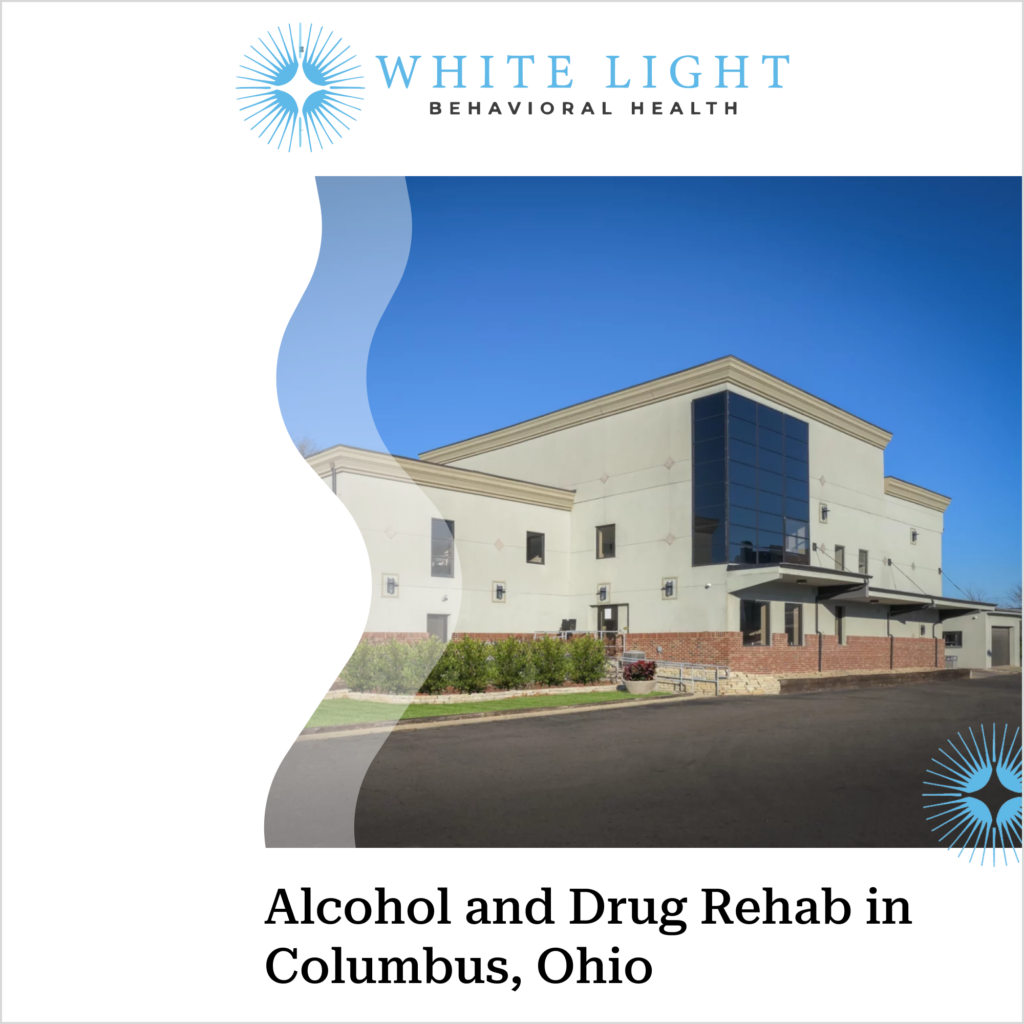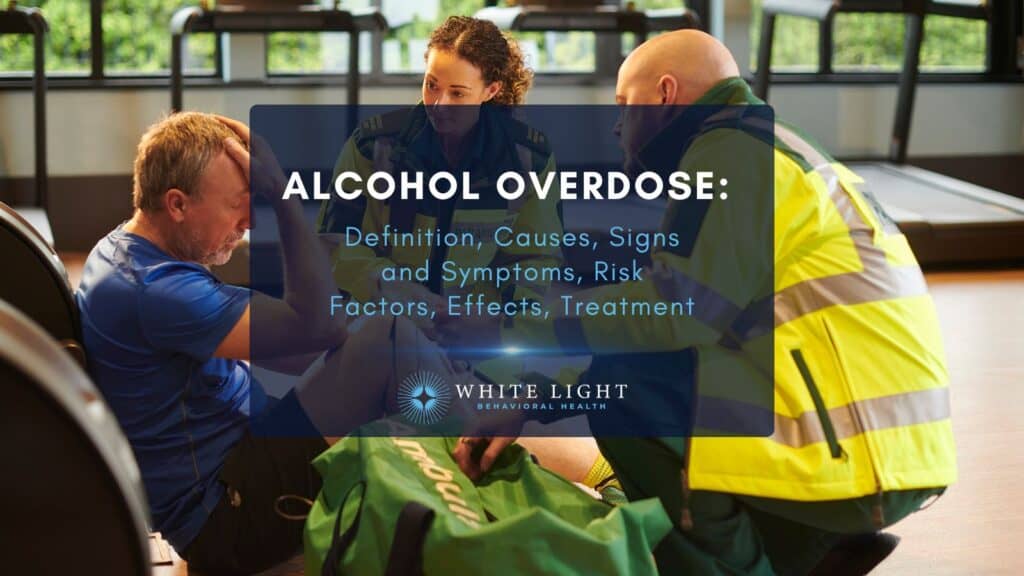Heroin: Definition, Usage, Effects, Overdose, and Withdrawal
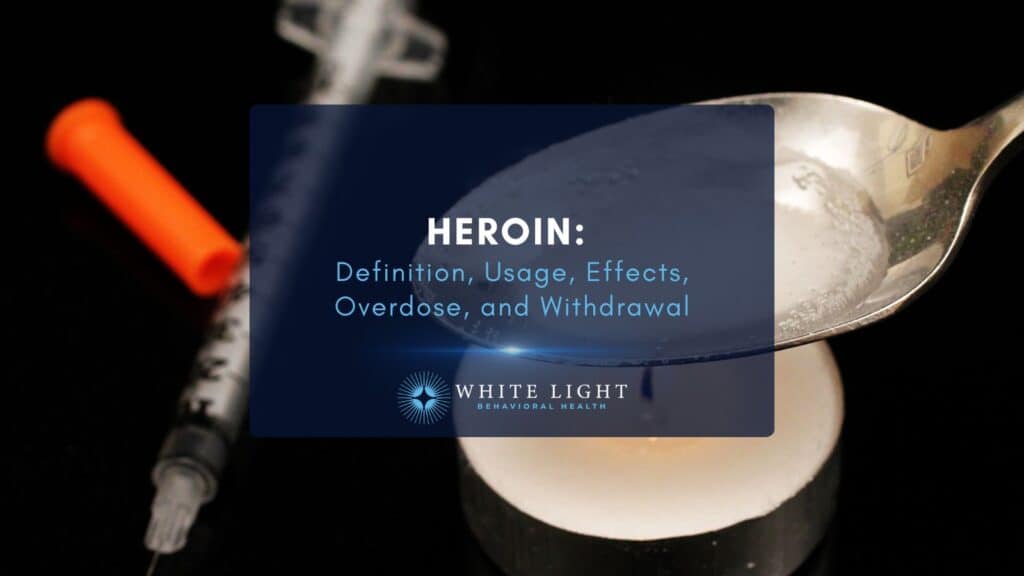
Heroin is a potent, illegal opioid derived from morphine, widely known for its ability to create intense euphoria. As a central nervous system depressant, it has a high potential for abuse and addiction. Heroin is trafficked illicitly, and its use poses significant health risks due to its potency and addictive nature.
The 2021 National Survey on Drug Use and Health (NIDA) found that 0.4% of people aged 12 or older, around 1.1 million individuals, used heroin in the past year. Approximately 9,173 Americans died from heroin overdoses in 2021, emphasizing the ongoing impact of addiction.
Heroin is commonly used by injection, snorting, or smoking. Each method delivers the drug rapidly to the brain, causing intense euphoria and reinforcing continued use. While some users seek heroin for its euphoric effects, others turn to it to relieve pain or stress, further fueling its addictive properties.
The major health effects of heroin use include respiratory depression, impaired judgment, and weakened immune function, as studied by WebMD. Long-term use leads to chronic health issues such as liver disease, heart problems, and infectious diseases like HIV and Hepatitis C due to shared needles. Brain function also be impaired, affecting cognition and memory.
Heroin overdose is a significant risk, as the drug depresses the respiratory system, leading to slowed or stopped breathing. Overdose symptoms include bluish lips or nails, pinpoint pupils, and loss of consciousness. Fatal overdoses are a frequent consequence, exacerbated by the presence of other substances like fentanyl.
Withdrawal from heroin is marked by flu-like symptoms, intense cravings, anxiety, and muscle pain. While withdrawal is uncomfortable and difficult, it is managed through medical detoxification, medication-assisted treatment (MAT), and therapy. According to a study by the National Institute on Drug Abuse titled “Can addiction be treated successfully?” 75% of people suffering from any addiction, including heroin addiction, recover with proper management and support.
What is Heroin?
Heroin is a highly addictive opioid drug chemically classified as diacetylmorphine (C₂₁H₂₃NO₅). It is synthesized from morphine, a natural alkaloid derived from the seed pods of the opium poppy plant (Papaver somniferum).
Through acetylation, morphine is converted into heroin, increasing its lipid solubility, which allows for rapid absorption into the brain and a more intense euphoric effect. This modification enhances its potency and contributes to its high addiction potential.
The Drug Enforcement Administration (DEA) classifies heroin as a Schedule I controlled substance, meaning it has no accepted medical use and a high potential for abuse. As an opioid, it binds to opioid receptors in the brain, producing powerful pain-relieving and euphoric effects. Unlike prescription opioids such as oxycodone and fentanyl, heroin is entirely illegal for medical or recreational use in the United States and many other countries due to its severe health risks and potential for addiction.
Heroin is primarily derived from morphine, which is extracted from opium poppy plants cultivated in regions such as Afghanistan, Myanmar, and Mexico. Its production and distribution are illegal in most countries because of its association with addiction, overdose, and widespread public health crises. Despite strict regulations, heroin remains widely available in illicit markets, cut with harmful substances that increase its dangers.
More Resources on Addiction:
Did you know most health insurance plans cover substance use disorder treatment? Check your coverage online now.
What Does Heroin Look Like?
Heroin looks like a powdery or sticky substance that varies in color from white to dark brown or black, depending on its purity and processing methods. Its appearance is influenced by the region where it is produced and the cutting agents used to dilute it for street sale.
The different forms of Heroin are as follows:
- White Powder Heroin: This is the purest form of heroin found in the eastern United States. It is a fine, white, or off-white powder with high purity levels, making it highly potent.
However, street heroin is cut with substances like lactose, quinine, or fentanyl to increase profits and alter its effects.
- Brown Powder Heroin: Less refined than white powder heroin, this form appears as a coarse brown powder. It is commonly found in parts of Europe and the western United States.
Brown heroin has lower purity levels and is mixed with additives such as sugar, caffeine, or powdered milk, which affect its potency and solubility.
- Black Tar Heroin: This form is sticky, resembling roofing tar or a hard, dark resin. Primarily produced in Mexico, it is commonly found in the western United States.
Due to its crude processing, black tar heroin has lower purity levels and contains more impurities, making it harder to dissolve and increasing the risk of vein damage when injected.
What Are the Street Names of Heroin?
The street names of heroin are Smack, H, and Junk, among many others. These slang terms exist within drug culture to disguise conversations about the drug, making it harder for law enforcement to track illicit trade.
Street names vary by region, dealer preferences, and the form of heroin being sold.

The street names of heroin are as follows:
- Smack: Smack is one of the most widely recognized slang names. It originates from the drug’s powerful impact on the body, leaving users feeling numb and sedated.
- H: H is a shorthand term derived from the first letter of Heroin.
It is commonly used among drug users and dealers in coded conversations.
- Junk: Junk is the name that reflects the drug’s association with addiction and the way it leads individuals into self-destructive lifestyles, losing everything to their dependence.
- Black Tar: Black tar refers specifically to the dark, sticky form of heroin. This name is commonly used in the western United States, where this type is more prevalent.
- Chiva: Chiva is Spanish slang for heroin.
It is a term used in Hispanic communities, particularly in Mexico and the southwestern U.S.
- Horse: Horse is a name that signifies the drug’s strong, overwhelming effects. It is described as hitting users with the force of a galloping horse.
- Thunder: The name Thunder comes from the intense rush users experience upon injection, creating a powerful and fast-acting high.
- China White: China White refers to a high-purity, white powder form of heroin originating from Southeast Asia, which is known for producing some of the strongest heroin.
- Dope: Dope is a generalized slang term for drugs.
It is commonly used to refer to heroin, though it also applies to other substances like cannabis and methamphetamine.
- Hell Dust: Hell Dust term reflects heroin’s devastating effects, highlighting its role in addiction, destruction, and overdose deaths.
How Is Heroin Used?
Heroin is used by injection, snorting, and smoking, with each method affecting how quickly the drug enters the bloodstream and impacts the body. Injection delivers the fastest and most intense high, while snorting and smoking still produce strong effects but take slightly longer to act. All methods carry serious health risks, including addiction and overdose.
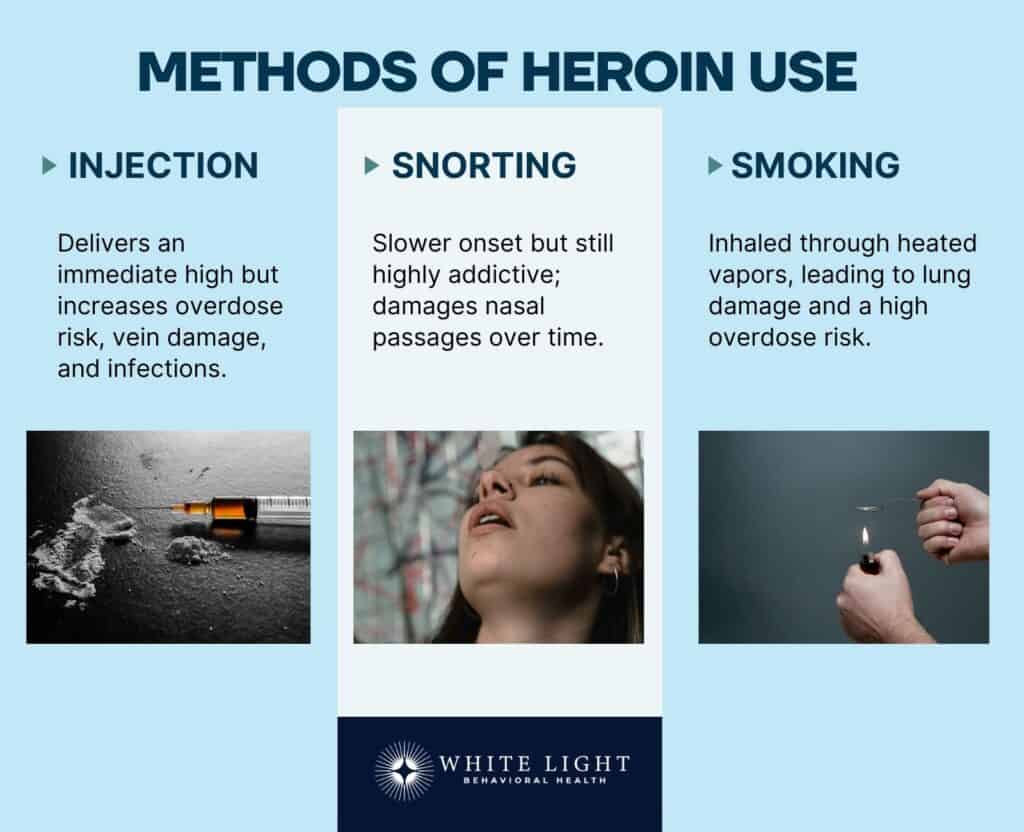
Heroin is used in the following methods:
- Injection: The most dangerous and direct method, injection delivers heroin straight into the bloodstream, producing an almost immediate and intense euphoric high. This method significantly increases the risk of overdose due to rapid absorption, and frequent use leads to collapsed veins, infections, and diseases like HIV and hepatitis from needle sharing.
- Snorting: Snorting heroin involves inhaling the powdered form through the nose, where it is absorbed through the nasal membranes.
While this method delays the onset of effects compared to injection, it still carries a high risk of addiction. Over time, snorting causes severe damage to the nasal passages and leads to chronic sinus issues.
- Smoking: Also known as chasing the dragon, smoking heroin involves heating the drug on foil or in a pipe and inhaling the vapors.
This method delivers heroin into the lungs, where it is rapidly absorbed into the bloodstream. While smoking heroin avoids the risks associated with needles, it still leads to severe addiction, lung damage, and an increased risk of overdose.
Why Do Some People Use Heroin?
Some people use heroin because of psychological, social, and economic factors that drive them toward substance abuse.
Psychologically, individuals struggling with mental health disorders such as depression, anxiety, or trauma use heroin as a way to escape emotional pain. The drug’s ability to produce intense euphoria and relaxation makes it appealing to those seeking relief from stress or negative emotions.
Socially, peer pressure, exposure to drug use in communities, and a lack of strong support systems contribute to heroin experimentation and eventual addiction. Many individuals who grow up in environments where drug use is common see heroin as a normalized coping mechanism.
Economically, poverty, unemployment, and financial instability push people toward heroin use, either as a way to self-medicate or because it is a cheaper alternative to prescription opioids. These combined factors create a cycle of addiction that is difficult to break, making heroin a persistent public health crisis.
How Does Heroin Affect the Brain and Body?
Heroin affects the brain by binding to opioid receptors, causing an intense rush of euphoria followed by sedation. Once heroin enters the brain, it is rapidly converted into morphine, which attaches to mu-opioid receptors (MORs).
These receptors are responsible for pain relief and pleasure, as well as regulating important functions like breathing and heart rate. According to a study by Kosten TR and George TP et al. 2002, titled “The Neurobiology of Opioid Dependence: Implications for Treatment,” heroin overstimulates these receptors, flooding the brain with dopamine, a neurotransmitter associated with pleasure and reward.
This unnatural surge in dopamine reinforces drug-seeking behavior, making heroin highly addictive.
Over time, heroin alters brain structure and function, impairing cognitive abilities and emotional regulation. Chronic heroin use weakens the brain’s white matter, reducing decision-making skills, behavior control, and responses to stress, as reported by the National Institute on Drug Abuse (NIDA) in “What Are the Long-Term Effects of Heroin Use?” The brain becomes dependent on heroin to release dopamine, diminishing its ability to experience pleasure from natural rewards like food and social interactions. This neurological adaptation contributes to tolerance, dependence, and withdrawal symptoms, trapping users in a cycle of addiction.
In addition to affecting the brain, heroin depresses the central nervous system (CNS), slowing heart rate, breathing, and other basic functions. The Maudsley Biomedical Research Center states in “Heroin Injection Associated with a Respiratory Disorder” that heroin-induced respiratory depression is a leading cause of overdose deaths.
The drug suppresses signals from the brainstem that regulate breathing, which results in hypoxia, a dangerous condition where oxygen levels drop, leading to brain damage or death. This extreme CNS depression, combined with heroin’s impact on the brain’s reward system, highlights the severe and fatal consequences of heroin addiction.
Contact us today to schedule an initial assessment or to learn more about our services. Whether you are seeking intensive outpatient care or simply need guidance on your mental health journey, we are here to help.
What Are the Short-Term Effects of Heroin?
The short-term effects of heroin are euphoria, slowed breathing, nausea, dry mouth, and drowsiness, which occur within minutes of use. Heroin rapidly enters the brain, binding to opioid receptors and triggering an intense but short-lived rush of pleasure, followed by a state of sedation and reduced physiological function. The severity and duration of these effects depend on the dose, purity, and method of use.

The short-term effects of heroin are as follows:
- Euphoria: Heroin induces an intense feeling of pleasure and relaxation by flooding the brain with dopamine. This effect begins within seconds when injected and within minutes when snorted or smoked.
The euphoric rush is short-lived, lasting only a few minutes, followed by drowsiness and clouded thinking.
- Slowed breathing (Respiratory depression): Heroin depresses the central nervous system, significantly slowing breathing and heart rate. According to the Maudsley Biomedical Research Center in “Heroin Injection Associated with a Respiratory Disorder,” this effect leads to dangerously low oxygen levels (hypoxia), causing unconsciousness or death.
Respiratory depression begins within 5 to 10 minutes of heroin use and persists for several hours.
- Nausea and vomiting: Many heroin users experience nausea and vomiting as the drug affects the brainstem’s chemoreceptor trigger zone. This response is more common in new users or those taking high doses.
The nausea usually starts within 5 to 20 minutes of heroin use and lasts for several hours.
- Dry mouth: Heroin reduces saliva production, leading to cottonmouth, a common side effect of opioid use. This dryness causes discomfort and difficulty swallowing.
It usually occurs within minutes of heroin entering the bloodstream and lasts several hours after the drug’s effects wear off.
- Drowsiness (sedation): After the initial rush, heroin users experience a state of extreme relaxation and drowsiness, sometimes referred to as being “on the nod,” a cycle of semi-consciousness and wakefulness. This effect begins within 10 to 20 minutes of use and lasts for several hours, increasing the risk of overdose if breathing becomes dangerously slow.
What Are the Long-Term Effects of Heroin?
The long-term effects of heroin are brain structure changes, dependence, mental health issues, liver and kidney disease, infectious diseases such as HIV and Hepatitis C, and heart infections.
Chronic heroin use leads to severe physical and psychological deterioration, making it difficult for individuals to quit without medical intervention. Over time, heroin alters brain function, damages vital organs, and increases the risk of life-threatening diseases.
The long-term effects of heroin are as follows:
- Brain structure changes: Chronic heroin use alters the brain’s white matter, impairing decision-making, behavior regulation, and stress response. According to the National Institute on Drug Abuse in “What Are the Long-Term Effects of Heroin Use?” these neurological changes contribute to long-term cognitive dysfunction, making it harder for users to resist cravings and recover from addiction.
- Dependence and addiction: With repeated heroin use, the brain adapts by reducing natural dopamine production, leading to tolerance, where higher doses are needed to achieve the same effect.
Over time, users develop dependence, experiencing severe withdrawal symptoms when they stop using. The International Classification of Diseases (ICD-10) classifies heroin addiction under “Opioid Dependence (F11.2)”, highlighting its recognized medical severity.
- Mental health issues: Long-term heroin use is linked to depression, anxiety, and an increased risk of suicidal thoughts.
The constant cycle of euphoria and withdrawal leads to emotional instability and psychiatric disorders, making recovery even more difficult without proper mental health support.
- Liver and kidney disease: Chronic heroin use damages the liver, especially in individuals with Hepatitis C or HIV, as stated in “LiverTox: Clinical and Research Information on Drug-Induced Liver Injury.” Heroin use affects blood flow and filtration in the kidneys, increasing the risk of renal disease and failure, according to Sethi S. et al., 2018, titled “The Changing Spectrum of Heroin-Associated Kidney Disease.”
- Infectious diseases (HIV, Hepatitis C): Heroin injection increases the risk of bloodborne diseases due to needle sharing. The Centers for Disease Control and Prevention (CDC) reported that over 50% of new Hepatitis C infections in the U.S. are linked to intravenous drug use, with heroin users being among the highest-risk populations.
Similarly, HIV transmission is a major concern in communities with high rates of injection drug use.
- Heart infections (endocarditis): Long-term heroin use causes bacterial infections of the heart lining and valves, a condition known as infective endocarditis. According to Heart.org in “Illegal Drugs and Heart Disease,” heroin users, particularly those who inject the drug, are at an increased risk due to unsterile injection practices and the presence of cutting agents that damage blood vessels.
Can Heroin Cause Gastrointestinal Problems?
Yes, heroin can cause significant gastrointestinal problems due to opioid-induced bowel dysfunction (OIBD).
Long-term heroin use slows digestion, leading to chronic constipation, bloating, nausea, and gastroparesis, a condition where the stomach empties slowly, causing severe discomfort. According to Camilleri M. et al., 2017, in their study “Opioid-Induced Constipation: Mechanisms and Management,” opioids like heroin reduce intestinal motility by binding to mu-opioid receptors in the gut, leading to opioid-induced constipation (OIC).
This condition persists even after stopping heroin use, requiring medical treatment to restore normal bowel function.
Can Heroin Cause High Blood Pressure?
Yes, heroin can cause high blood pressure during withdrawal and overdose situations despite being a central nervous system (CNS) depressant that lowers blood pressure. During withdrawal, the body experiences cardiovascular stress, leading to hypertension risk, rapid heartbeat, and anxiety-induced spikes in blood pressure.
Research by Kosten TR, Baxter LE., 2019, titled “Review of the Effects of Opioids on Cardiovascular Health” on heroin withdrawal indicates that abrupt cessation triggers a sympathetic nervous system overreaction, increasing blood pressure and heart rate. In contrast, heroin overdose leads to dangerously low blood pressure, causing cardiovascular collapse. These fluctuations pose significant health risks, especially for individuals with preexisting heart conditions.
Can Heroin Cause High Cholesterol?
No, heroin cannot cause high cholesterol directly, but poor nutrition and metabolic changes in long-term heroin users contribute to dyslipidemia. Many individuals with heroin addiction suffer from malnutrition, irregular eating habits, and a lack of fundamental nutrients, which leads to abnormal cholesterol levels. Prolonged opioid use is associated with metabolic changes that affect fat metabolism and insulin resistance, increasing the risk of cardiovascular disease.
A study by Fareed et al., 2013, titled “Opioid Use Disorder and Metabolic Syndrome,” found that heroin users exhibit elevated triglycerides and low HDL (good cholesterol) due to lifestyle factors and physiological stress. Over time, these imbalances contribute to an increased risk of heart disease and other metabolic disorders.
What Happens During a Heroin Overdose?
During a heroin overdose, the body’s central nervous system is severely depressed, leading to dangerously slow or stopped breathing, unconsciousness, and potentially death. The lack of oxygen causes brain damage, coma, or fatal organ failure within minutes if medical intervention is not provided.
Heroin overdoses are especially dangerous due to the unpredictable purity levels and the presence of cutting agents that amplify toxicity. According to the Centers for Disease Control and Prevention (CDC) 2021 report, there were approximately 9,173 heroin overdose deaths in the United States.
During a heroin overdose, the following complications happen:
- Respiratory Depression: Heroin suppresses the brain’s ability to regulate breathing, leading to slow, shallow, or completely stopped breathing. This lack of oxygen, known as hypoxia, causes irreversible brain damage or death, as cited in the National Institute on Drug Abuse (NIDA) report, “What is the impact of heroin overdose?”.
- Unconsciousness and Coma: Overdosing on heroin results in deep sedation or complete unconsciousness, making it impossible for the person to respond to external stimuli.
If left untreated, this progresses into a coma due to prolonged oxygen deprivation.
- Cyanosis (Bluish Skin and Lips): As breathing slows, oxygen levels in the blood drop, causing the skin, lips, and fingertips to turn blue or gray. This is an important warning sign that the body is not receiving enough oxygen and requires immediate medical attention.
- Weak or No Pulse: A heroin overdose severely depresses heart function, leading to an irregular heartbeat or cardiac arrest.
As the brain is deprived of oxygen, vital organs begin to shut down, increasing the risk of sudden death.
- Choking and Aspiration: Many overdose victims experience vomiting due to heroin’s effects on the digestive system. If the person is unconscious, they choke on their vomit, leading to aspiration pneumonia or suffocation.
- Seizures and Brain Damage: In some cases, heroin overdose leads to seizures due to oxygen deprivation and opioid-induced neurotoxicity.
Prolonged oxygen loss increases the risk of permanent neurological impairment, affecting memory, cognition, and motor function.
What Are the Signs of a Heroin Overdose?
The signs of a heroin overdose are slow or irregular breathing, blue lips, coma, and nausea. These are telltale indicators that the body’s systems are failing due to excessive heroin use.
These signs, stemming from respiratory depression and the drug’s effects on the brain, require immediate medical attention. Without quick intervention, an overdose results in brain damage, organ failure, or death.

The signs of a heroin overdose are as follows:
- Slow or Irregular Breathing: One of the most dangerous signs of an overdose is respiratory depression, where breathing becomes abnormally slow, shallow, or stops completely. This occurs because heroin depresses the brain’s ability to regulate respiration, drastically reducing the oxygen reaching vital organs, according to WebMD “Heroin: Effects, Addiction, and Withdrawal Symptoms.” Severe respiratory depression leads to hypoxia, which causes brain damage or death if not treated immediately.
- Blue or Purple Lips and Nails (Cyanosis): As breathing slows and oxygen levels in the body drop, the skin, particularly around the lips and fingernails, takes on a bluish or purplish color.
This is called cyanosis, a direct result of insufficient oxygenation. Cyanosis is a clear sign that the body is in distress and requires urgent medical intervention.
- Unconsciousness or Coma: Overdose victims become unresponsive or unconscious due to the sedative effects of heroin.
The drug suppresses the central nervous system, which leads to coma if the overdose is severe enough, according to a study by Schiller EY, Goyal A, Mechanic OJ. et al. 2023, titled “Opioid Overdose.” Without immediate treatment, prolonged unconsciousness results in permanent brain damage or death.
- Pinpoint Pupils: Heroin constricts the pupils, leading to pinpoint pupils (miosis). This occurs because of heroin’s effect on the brain’s opioid receptors, which control pupil size.
Pinpoint pupils are a reliable sign of opioid overdose, and the smaller the pupils, the more severe the overdose.
- Vomiting or Nausea: Heroin depresses the gastrointestinal system, leading to nausea and vomiting. When unconscious, individuals are at risk of aspirating vomit, which causes choking or leads to aspiration pneumonia, a potentially fatal condition.
- Weak or Absent Pulse: Heroin overdose causes cardiovascular depression, resulting in a weak or absent pulse.
This occurs because heroin lowers heart rate and blood pressure. If not addressed quickly, the lack of a pulse results in cardiac arrest, which is fatal without immediate intervention.
How Can a Heroin Overdose Be Treated?
A heroin overdose can be treated with a combination of emergency medical interventions aimed at reversing the effects of the overdose and stabilizing the person. The first and most important step is the administration of naloxone (Narcan), an opioid antagonist that reverses the effects of opioid toxicity, including respiratory depression.
CPR (Cardiopulmonary Resuscitation) is necessary if the person’s heart stops or breathing becomes too slow to sustain life. Emergency medical services (EMS) are necessary to provide advanced care, including intubation and IV medications.

The treatment options for a heroin overdose are as follows:
- Naloxone (Narcan): Naloxone is a life-saving medication that reverses the effects of an opioid overdose by blocking the opioid receptors in the brain, effectively reversing respiratory depression and restoring normal breathing. Naloxone has been shown to be highly effective, with success rates of around 85% to 100% when administered properly in an opioid overdose, Rzasa Lynn R, Galinkin JL. et al. 2018, titled “Naloxone dosage for opioid reversal: current evidence and clinical implications.”
- CPR (Cardiopulmonary Resuscitation): If the person’s breathing stops or becomes too weak, CPR helps maintain oxygen circulation and potentially restart the heart until emergency services arrive, according to a study by Seal KH. et al. 2005, titled “Naloxone distribution and cardiopulmonary resuscitation training for injection drug users to prevent heroin overdose death: a pilot intervention study.” Chest compressions should be initiated immediately, followed by rescue breaths if necessary.
- Emergency Medical Services (EMS): EMS teams are equipped to provide advanced medical treatment, such as oxygen therapy, intravenous fluids, and other interventions to stabilize the patient and prevent further harm from the overdose, according to a study by Chou R, Korthuis PT, McCarty D, et al. 2017, titled “Management of Suspected Opioid Overdose With Naloxone by Emergency Medical Services Personnel.”
Rediscover Life at White Light Behavioral Health
Get the compassionate support you deserve. We're here to help you reclaim joy, wellness, and a brighter future.
Our Facility
How Does Heroin Contribute to Overdose Deaths?
Heroin contributes to overdose deaths primarily through its unpredictable potency and the growing prevalence of fentanyl-laced heroin. Fentanyl, a synthetic opioid far more potent than heroin, is mixed with heroin to increase its effects. This unpredictability significantly raises the risk of overdose, as users are not aware of the presence of fentanyl and, therefore, consume a lethal dose.
Polydrug use, where heroin is combined with other substances like benzodiazepines, further exacerbates the risk of overdose deaths. Benzodiazepines, such as Xanax or Valium, depress the central nervous system and increase the likelihood of respiratory depression when taken with heroin. The combination of these drugs leads to a greater chance of fatal overdoses, as the central nervous system becomes dangerously suppressed.
Recent data shows that fentanyl-laced heroin is responsible for a substantial portion of overdose deaths. According to the CDC, fentanyl was involved in nearly 80% of all opioid-related deaths in the United States in recent years. Furthermore, combining heroin with other sedative drugs like benzodiazepines makes overdoses far more fatal, increasing the likelihood of death from respiratory failure or cardiac arrest.
What Is Heroin Withdrawal Like?
Heroin withdrawal is like a combination of flu-like symptoms, intense cravings, and severe anxiety. When someone stops using heroin, their body reacts to the absence of the drug, causing various physical and psychological symptoms. The symptoms include muscle aches, sweating, chills, nausea, vomiting, and diarrhea.
In addition to these, cravings for the drug are overwhelming, and anxiety increases significantly. This combination of physical discomfort and emotional distress makes withdrawal extremely difficult and challenging for many people attempting to stop heroin use.
How Long Does Heroin Withdrawal Last?
Heroin withdrawal lasts for approximately 1 to 2 weeks, as studied by Healthline. The process is divided into different phases: early withdrawal (6-12 hours after the last use), where initial symptoms like anxiety, yawning, and sweating begin; peak withdrawal (24-72 hours), when symptoms like nausea, vomiting, muscle cramps, and insomnia intensify; and finally, fading symptoms (1-2 weeks), where the physical discomfort starts to subside, but psychological symptoms like cravings and irritability persist. The intensity and duration of withdrawal vary depending on factors like the individual’s usage history and physical condition.
How Is Heroin Withdrawal Managed?
Heroin withdrawal is managed with a combination of medical support, detoxification, and medication-assisted treatment (MAT) to reduce symptoms and help individuals recover safely. The goal of management is to alleviate discomfort and ensure the person’s safety throughout the withdrawal process.
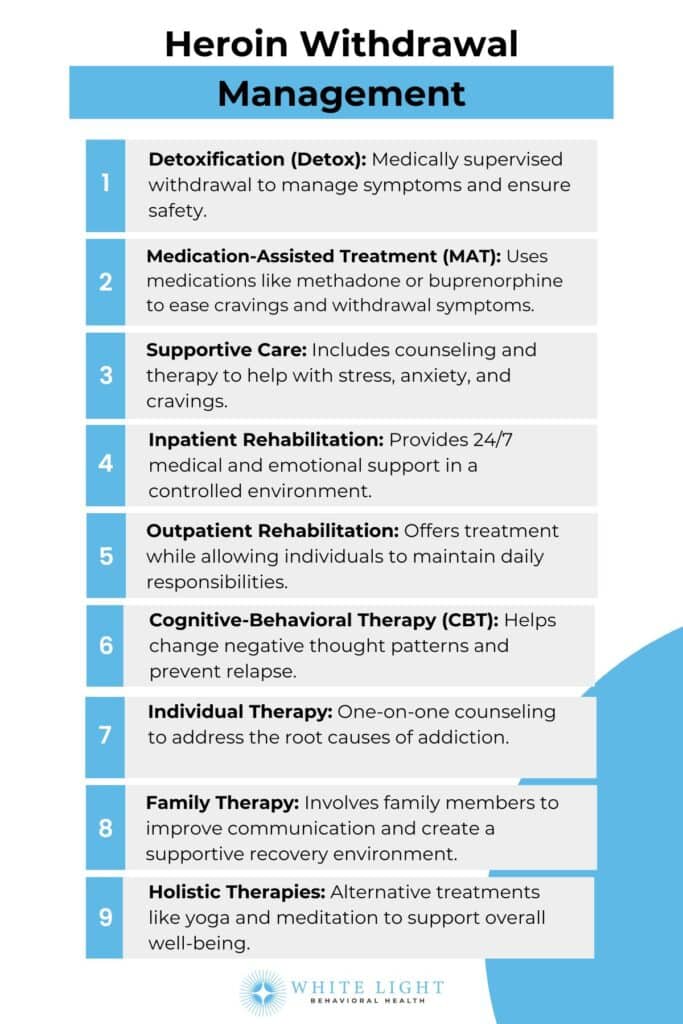
Heroin withdrawal is managed by the following methods:
- Detoxification (Detox): Detox involves medically supervised withdrawal, where the person is monitored for physical symptoms and given medications to reduce discomfort and manage any life-threatening symptoms, such as dehydration or seizures.
- Medication-Assisted Treatment (MAT): MAT includes the use of medications like methadone or buprenorphine to alleviate cravings and withdrawal symptoms. These medications are long-acting opioids that help stabilize the patient’s condition and ease the transition to recovery.
MAT has proven highly effective, showing a 50–60% success rate in long-term sobriety, as studied by Feelemyer J et al. 2014, titled “Retention of participants in medication-assisted programs in low- and middle-income countries: an international systematic review.”
- Supportive Care: Supportive care focuses on emotional and psychological support, including counseling and therapy, to help individuals manage anxiety, stress, and cravings. This involves one-on-one therapy, group therapy, or inpatient treatment programs.
- Inpatient Rehabilitation: Inpatient rehabilitation involves staying at a dedicated treatment center throughout the recovery process.
It provides round-the-clock medical care and emotional support in a controlled setting, free from external stressors and triggers. This type of treatment is particularly beneficial for heroin addiction, as it removes individuals from environments where heroin use is common.
The structured setting of inpatient rehab ensures that individuals receive continuous care, intensive therapy, and supervision, allowing them to concentrate fully on their recovery.
- Outpatient Rehabilitation: Outpatient rehabilitation offers individuals the flexibility to receive treatment for heroin addiction while remaining at home, which allows them to continue with daily activities such as work. While this treatment is less intensive than inpatient care, it is highly effective for those with mild to moderate addiction.
Outpatient programs include treatments such as medication-assisted therapy (MAT) or cognitive-behavioral therapy (CBT), helping individuals address the underlying causes of addiction while maintaining a level of flexibility.
- Cognitive-Behavioral Therapy (CBT): Cognitive-behavioral therapy (CBT) is a widely used approach in addiction treatment that assists individuals in identifying and altering negative thought patterns and behaviors linked to their heroin addiction. According to a study by Magill M, Kiluk BD, and Ray LA et al. 2023, titled “Efficacy of Cognitive Behavioral Therapy for Alcohol and Other Drug Use Disorders: Is a One-Size-Fits-All Approach Appropriate?”, CBT has been shown to improve recovery outcomes by up to 26%.
It equips individuals with strategies to manage stress, avoid relapse, and better cope with challenges, making it an important component of heroin addiction recovery.
- Individual Therapy: Individual therapy consists of private sessions between the patient and a licensed therapist, where the root causes of addiction are explored. These sessions provide a safe space to work through emotional and psychological challenges that contribute to heroin use while helping individuals develop personalized coping strategies, process past trauma, and set clear recovery goals.
- Family Therapy: Family therapy incorporates the patient’s family members into the recovery process, addressing dysfunctional dynamics that have contributed to substance abuse.
It encourages open communication and creates a supportive environment that encourages healing and long-term recovery, ultimately improving the family’s overall well-being.
- Holistic Therapies: Holistic therapies include alternative treatments such as yoga, acupuncture, and meditation that focus on healing the mind, body, and spirit. While not substitutes for conventional addiction treatments, these therapies complement traditional methods by alleviating stress, promoting emotional healing, and supporting overall recovery.
How Long Does Heroin Stay in Your System?
Heroin stays in your system for approximately 1 to 3 days on average, although this varies based on factors like metabolism, frequency of use, and dosage, according to WebMD. The half-life of heroin is very short, usually around 30 minutes to 1 hour, but its metabolites remain detectable for a longer period.
Heroin is detected in urine for 2 to 4 days after use, although chronic or heavy use extends this window. In blood, heroin is detectable for about 6 to 12 hours after use, while hair follicle tests detect heroin for up to 90 days.
These detection times are based on drug testing windows supported by research but vary depending on individual factors.
Are you covered for treatment?
White Light Behavioral Health is an approved provider for Blue Cross Blue Shield and TUFTS, while also accepting many other major insurance carriers.
Check Coverage Now!How Does Heroin Addiction Develop?
Heroin addiction develops when repeated use of the drug alters the brain’s chemistry, particularly the reward system. Over time, the brain becomes reliant on heroin to release dopamine, a neurotransmitter associated with pleasure and reward. As the body builds tolerance, individuals need larger amounts to achieve the same effect, increasing their dependence on the drug. This cycle of use, tolerance, and withdrawal strengthens the heroin addiction, leading to intense cravings and a loss of control over drug use, which exacerbates the psychological and physical dependence on heroin.
How Is Heroin Different from Prescription Opioids Like Fentanyl and Morphine?
Heroin is different from prescription opioids like fentanyl and morphine in several key ways, primarily regarding legality and medical use. Heroin is an illegal street drug with no accepted medical use, while fentanyl and morphine are prescribed by doctors for the treatment of severe pain in hospital settings. Morphine is commonly used to manage pain after surgeries or for cancer patients, and fentanyl is prescribed for more intense pain management, particularly in cases of advanced cancer or post-surgical recovery.
In terms of potency, fentanyl is significantly stronger than heroin, estimated to be 50 to 100 times more potent, according to DEA.gov in “Fentanyl.” This means that even a small amount of fentanyl leads to a fatal overdose, particularly when it is illicitly mixed with heroin or other drugs, making it much more dangerous. Heroin, while potent, has a more established route of use, but fentanyl’s high potency and ability to cause respiratory depression at smaller doses contribute to its increasing role in the opioid overdose crisis.
How Does Heroin Compare to Other Drugs?
Heroin is compared to other drugs like methamphetamine and cocaine in terms of addiction potential, withdrawal severity, and overdose risks. While meth and cocaine are both stimulants that increase heart rate and energy levels, heroin is a central nervous system depressant, slowing down heart rate and breathing. This difference makes heroin particularly dangerous in terms of overdose, as its respiratory depression leads to fatal outcomes.
A study by Hser YI et al. 2008, titled “Contrasting trajectories of heroin, cocaine, and methamphetamine use,” comparing addiction rates show that heroin’s potential for physical dependence and withdrawal severity tends to be more severe than that of cocaine or meth. Methamphetamine is highly addictive, but heroin’s withdrawal symptoms are more intense, involving pain, cravings, and gastrointestinal issues. Overdose risks are also higher for heroin, especially due to its potential to be laced with fentanyl, which significantly increases the risk of fatal overdose.
Is Heroin More Dangerous Than Meth?
Yes, heroin is more dangerous than methamphetamine (meth) due to its effects on the body, its overdose risk, long-term damage, and the challenges it poses in treatment. Heroin, being an opioid, acts as a central nervous system depressant, slowing down bodily functions, especially breathing. This leads to fatal respiratory depression in overdose situations. Methamphetamine, a stimulant, increases heart rate and causes hyperactivity, leading to potentially dangerous cardiovascular issues.
Heroin’s risk of overdose is higher because it easily causes breathing to stop, whereas meth overdoses primarily involve heart complications. In terms of addiction and withdrawal severity, heroin addiction is considered more physically debilitating, and its withdrawal symptoms are more severe.
Heroin overdoses also have a higher fatality rate compared to meth, as respiratory failure from heroin use is more difficult to reverse. A study by Carroll JJ et al. 2017, titled “Exposure to fentanyl-contaminated heroin and overdose risk among illicit opioid users in Rhode Island: A mixed methods study,” shows heroin’s higher fatality rate when combined with other substances like fentanyl.
Is Heroin More Addictive Than Cocaine?
Yes, heroin is more addictive than cocaine due to its stronger impact on the brain’s reward system and its potential for physical dependence. Heroin, as an opioid, creates a powerful euphoria and alters brain chemistry by flooding the brain with dopamine, making it highly reinforcing.
This intense rush leads to rapid physical dependence, and its withdrawal symptoms are severe, causing cravings, pain, and psychological distress.
Cocaine, while also highly addictive, acts as a stimulant that increases dopamine release but does not have the same level of physical dependence associated with heroin use. The effects of heroin are more short-acting, leading users to repeatedly administer the drug to avoid withdrawal, reinforcing its addictive nature. Cocaine’s longer-lasting effects reduce the urgency of use, but heroin’s potent and immediate effects contribute to stronger dependence and higher relapse rates.
The short-acting and long-acting effects of heroin are as follows:
- Dopamine release: Heroin creates an immediate and intense release of dopamine in the brain, which reinforces repeated use. The rapid onset of euphoria makes it highly addictive compared to cocaine, which, though it also boosts dopamine, does so in a way that does not induce the same level of compulsive drug-seeking behavior.
- Withdrawal severity: Heroin withdrawal symptoms are extremely intense, including muscle pain, anxiety, cravings, nausea, and other flu-like symptoms.
This physical dependence makes it harder to quit and is one of the reasons heroin is considered more addictive than cocaine, which has less physically debilitating withdrawal symptoms.
- Relapse rates: A study by Hser YI et al. 2008, titled “Comparing the dynamic course of heroin, cocaine, and methamphetamine use over 10 years,” has shown that heroin users experience higher relapse rates than those addicted to cocaine. The severity of heroin’s physical dependence and the intense cravings that occur during withdrawal contribute to this.
Heroin’s short-acting nature means users need to dose more frequently, further solidifying its addictive potential.
Did you know most health insurance plans cover substance use disorder treatment? Check your coverage online now.
What Are the Laws on Heroin in the U.S.?
The laws on heroin in the United States are stringent due to its classification as a Schedule I controlled substance by the Drug Enforcement Administration (DEA). This designation places heroin in the category of substances with no recognized medical use and a high potential for abuse.
The penalties for possessing, distributing, or manufacturing heroin are severe and result in long prison sentences. In the case of possession, a person faces up to 1 year in prison for a first offense, with longer sentences for repeat offenses.
Distribution of heroin leads to even harsher penalties, including federal charges that carry significant mandatory minimum sentences. In Ohio, heroin-related charges are similarly stringent, and the state has seen an increasing number of heroin-related arrests and deaths as the opioid crisis continues to escalate. According to the Federal Sentencing Guidelines, trafficking in heroin leads to penalties ranging from 5 to 40 years in prison, depending on the quantity of the substance involved and whether the offense involved distribution to minors or led to death.
How Many People Die from Heroin Use Each Year?
Approximately 9,173 people die from heroin use each year in the United States, according to the Centers for Disease Control and Prevention (CDC) data from 2021. This figure has fluctuated significantly due to the increasing involvement of fentanyl in heroin overdoses. In Ohio, the number of deaths from heroin-related causes has also risen, with fentanyl now being a leading factor in overdose fatalities.
The CDC has reported that opioid overdose deaths, including those from heroin, have surged among certain age groups, particularly individuals aged 25 to 44. Data shows that fentanyl, mixed with heroin, has contributed to a dramatic rise in overdose deaths in both the U.S. and Ohio, accounting for a large proportion of the fatalities. The demographic breakdown of heroin-related deaths shows that younger adults and middle-aged individuals are at the highest risk, with opioid overdoses now being a leading cause of death among this group.
Share This Post







